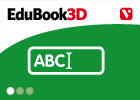Cargando...
Recursos educativos
-
Nivel educativo
-
Competencias
-
Tipología
-
Idioma
-
Tipo de medio
-
Tipo de actividad
-
Destinatarios
-
Tipo de audiencia
-
Creador
Lo más buscado
- Aprender a dividir
- Ejercicios escolares para niños de 5 años
- Aprender a leer jugando
- El método científico
- Carga positiva
- Repaso de la multiplicación
- Repaso de tiempos verbales en inglés
- Imprimir material
- Capitales de Asia
- Leonardo da Vinci
- Juegos para aprender
- Horas del reloj
- Aparato reproductor femenino
- Repaso de biología
- ejercicios matemáticas
-

Living things
EduBook Organización
- 1 lo usan
- 5623 visitas
There are a great variety of living things on the Earth. Some are microscopic and very simple, like bacteria, and others are very big and complex, like elephants. Even though they are different, all…
-

Self-assessment T8 10 - Nutrition, breathing and circulation
EduBook Organización
- 5641 visitas
Are these sentences true or false? The urinary system consists of the kidneys and the ureters. The circulatory system transports nutrients to all the cells in our body. The kidneys extract water and…
-

Remember - Animal nutrition
EduBook Organización
- 5576 visitas
Animals are heterotrophic organisms; they cannot make the organic material they need to eat. They can get organic material from other animals and from plants. Plants are the only living things that can…
-

Biblioteca d'imatges de la cèl·lula
Irene Salomé Martínez Pérez Docente
- 2 lo usan
- 4695 visitas
The Cell: An Image Library™ is a freely accessible, easy-to-search, public repository of reviewed and annotated images, videos, and animations of cells from a variety of organisms, showcasing cell…
-

Introduction - Animal nutrition
EduBook Organización
- 5513 visitas
Animals are heterotrophic organisms; they cannot make the organic material they need to eat. They can get organic material from other animals and from plants. Plants are the only living things that can…
-

End-of-unit activities - Living things
EduBook Organización
- 4870 visitas
There are a great variety of living things on the Earth. Some are microscopic and very simple, like bacteria, and others are very big and complex, like elephants. Even though they are different, all…
-

End-of-unit evaluation - Living things
EduBook Organización
- 1 lo usan
- 4458 visitas
There are a great variety of living things on the Earth. Some are microscopic and very simple, like bacteria, and others are very big and complex, like elephants. Even though they are different, all…
-

Introduction - Living things
EduBook Organización
- 4649 visitas
There are a great variety of living things on the Earth. Some are microscopic and very simple, like bacteria, and others are very big and complex, like elephants. Even though they are different, all…
-

Complete. Blood vessels
EduBook Organización
- 4554 visitas
Complete these sentences with the correct words: Blood circulates around our body through tubes called . Arteries carry blood containing oxygen from the to the capillaries. The are narrow blood vessels…
-

Summaries - Plant nutrition
EduBook Organización
- 4536 visitas
1. What plants need Nutrition is all of the processes that living things use to convert the foods they ingest. They transform these nutrients into biomolecules that they need to make cells and tissues.…
Te estamos redirigiendo a la ficha del libro...













